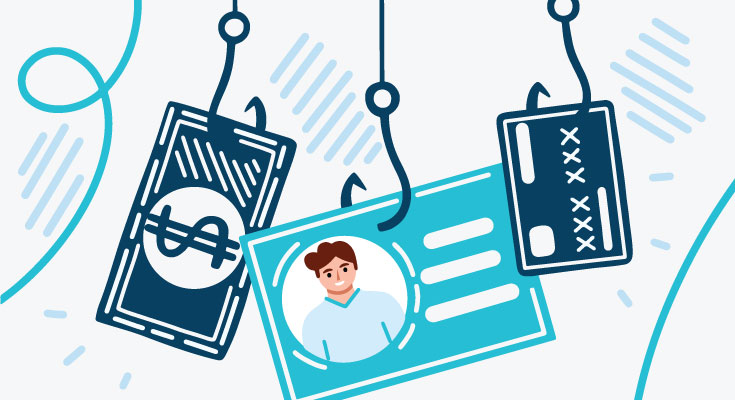Out of all the online frauds, synthetic identity fraud is one of the fastest-growing threats in the U.S. Traditional methods of detection and prevention of fraud are failing when it comes to synthetic ID fraud. Synthetic identity fraud is a type of fraud where fraudsters combine fake and real information such as real stolen social security numbers and fake names to create a whole new persona. Fraudsters then use this new identity to complete a number of fraudulent activities. This new identity can affect financial institutions, government agencies, or individuals by opening a new fake account.
Synthetic identities are a growing threat in the US. This is because identity verification in the US leverages personally identifiable information (PII) like SSNs. According to a report by the FTC, synthetic identity fraud is the fastest-growing type of financial crime in the US.
One of the biggest reasons why synthetic identity fraud is growing is because it is hard to detect. Victims of these frauds are typically individuals who are less likely to access their credit information regularly, such as children or the elderly. Plus, fraudsters often nurture these identities over time, and then they apply for more and more credit and build up a positive online payment history.
Synthetic identities often go years without being detected. This is one of the reasons why identity fraud is so attractive to fraudsters. Synthetic ID fraud is a fraud committed by expert fraudsters.
What Exactly Is Synthetic Identity Theft?
Synthetic identity theft involves stealing an individual’s Social Security number (SSN) and combining it with invented personal data—name, date of birth, address, email, and phone number—to form a new identity.
It’s Hard to Spot Conventional fraud detection struggles to identify synthetic identity theft. Children, seniors, and homeless individuals are commonly targeted due to limited credit usage and monitoring.
The Creation Process Fraudsters can create synthetic identities through several methods:
- SSN Theft: Stolen SSNs are combined with fabricated information in identity compilation.
- Manipulated Data: Genuine personal data is slightly altered to establish a new persona using identity manipulation.
- Fabricated Identity: Bogus personal information is used to craft an entirely false identity via identity fabrication.
Difference Between Synthetic ID Fraud & Traditional Fraud Methods
Traditional fraud usually involves a fraudster impersonating someone else. They will use stolen identity documents or information to commit fraud. These types of fraudsters tend to max out the credit limit as soon as possible before the victim notices the fraud. Most financial institutions send alerts to the victims about suspicious activities and that’s why this type of identity fraud is detected easily.
Synthetic ID fraud in comparison combines real stolen information and fake information to create a completely new identity. There are several ways this can be achieved:
- IdeIdentity fabrication- creating a completely fictitious identity without any real personally identifiable information.
- Identity manipulation- fraudsters create a modified real PII for building a new identity.
- Identity compilation- a combination of fake and real PII, such as a false driver’s license to build a new identity.
By combining real and fake information, detecting synthetic ID fraud becomes much more difficult. Especially when the real information is stolen from those who are less likely to keep their eye on their credit files. In a lot of cases, synthetic identity fraud can go undetected for a long time.
Purpose of Synthetic Identities
Synthetic identities are mainly employed for financial fraud. Identity thieves use these to acquire loans, credit cards, bank accounts, and more. They can even file taxes, access medical care, and apply for unemployment benefits with fake identities.
This process can be prolonged, spanning years to build a credible synthetic profile, complete with a substantial credit history and reliable credit scores.
Fraud Avenues Synthetic identities enable various fraudulent activities:
- Organized Crime: Crime rings use synthetic identities to access or store illegally obtained funds.
- Loan Scams: Fraudsters secure personal loans, default, and abscond with the money.
- Evasion: Criminals evade prosecution by assuming synthetic identities.
Repercussions of Victimhood Detection prove challenging due to the legitimacy of synthetic identities. Lenders and banks struggle to identify these fraudulent accounts, targeting individuals with infrequent credit access.
Fraudulent SSN use results in fragmented credit files, mixing your legitimate data with synthetic identity details. Negative judgments stemming from this mix can harm your credit scores and untangling the records can be arduous.
How Synthetic Identity Fraudsters Commit Crime?
- They Create a New Fake Identity
The process usually starts on the dark web. A fraudster can easily purchase stolen PII that is obtained with data breaches or other methods. Or sometimes they’ll use a completely fake identity for fraud.
- They Apply for Credit
Using the new synthetic identity, a fraudster applies for credit online. The financial institution the fraudsters apply to sends their query to the bureaus for checking. This initial application is often as the new synthetic identity doesn’t have a credit history. Although, the application is enough to start a new credit record.
- Fraudsters Keep on Trying Till They’re Successful
The fraudsters keep on applying at various financial institutions until they’re approved by anyone. Most of the time, it’s a high-risk lender who approves. They continue to build this line of credit making timely repayments and building up a good credit reputation. With a good enough credit history, fraudsters can gain access to lower-risk lenders and higher credit limits. Building this reputation takes months or even years and on paper, fraudsters look like any other credit users.
- They Accelerate a Positive Credit History
Some fraudsters accelerate their credit history process by piggybacking. Fraudsters are added as authorized users to an account with a good credit history. Authorized users are compensated for this process. The fraudsters will use several tactics to make the synthetic identities even more real. Thus making it harder to detect with traditional methods.
- They Take Advantage of Their Efforts
Eventually, the fraudsters will take advantage of the reputation they’ve built up over time. Once they secure a large line of credit, they will max out the credit line before vanishing forever. It’s also possible for the fraudsters to double their profits by claiming identity theft on their accounts and get the charges removed. Or they can even use fake cheques to pay off the balance before maxing out the credit limit.
Protecting Against Synthetic Identity Theft
Following these fraud prevention strategies are crucial to ensure a fraudster doesn’t steal your identity information.
- Secure Your SSN: Safeguard your SSN. Store your Social Security card safely at home, and avoid disclosing it in public. Dispose of documents containing personal data securely.
- Digital Security: Utilize comprehensive digital security software to guard against hacking and malware.
- Phishing Awareness: Beware of phishing scams through emails, texts, and calls. Scrutinize sources, avoiding unexpected requests for personal data.
- Monitor Credit: Regularly review credit reports and scores for discrepancies. Place fraud alerts or security freezes to guard against unauthorized credit activity.
Safeguarding your SSN and practicing digital security can help mitigate the risks of synthetic identity theft. Stay vigilant and take preventive measures to protect your financial well-being.
Impact of Synthetic ID Fraud on Businesses
Due to its hard-to-detect nature, there’s no way to tell how this type of fraud impacts businesses. In the US, lost credit-card accounts lost $820 million to synthetic identity fraud in 2018 and the losses are expected to cross $2 billion by the end of 2021. However, this data doesn’t account for the loss of personal time and aggravation for the victims.
Synthetic identity fraud is costing businesses billions of dollars. Plus the amount of time financial institutions spend chasing down people who don’t exist. Clearly, synthetic ID fraud is a growing threat, so businesses need a more efficient process to verify if the users are authentic or not. Traditional tools that are meant to reduce identity fraud can’t keep up with synthetic identity fraud.
Businesses need to invest in the latest and more sophisticated methods like DIRO’s original document verification technology. It verifies documents instantly and verifies customer data from original sources to reduce the use of fake and stolen information.
FAQs
- What is synthetic identity theft fraud?
Synthetic identity theft fraud occurs when criminals create fictitious identities by combining real and fake information, often involving social security numbers, names, addresses, and other data.
They then use these synthetic identities to open fraudulent accounts or apply for credit, aiming to build a credit history and obtain financial benefits.
- How does synthetic identity theft differ from traditional identity theft?
In traditional identity theft, a criminal uses another person’s legitimate identity information. In synthetic identity theft, the criminal creates a new identity that may not correspond to any real individual, making it harder to detect.
- How do fraudsters create synthetic identities?
Fraudsters often combine real and fake information to create a synthetic identity. They might use a real social security number with a fabricated name, address, and other details. Alternatively, they might use various fabricated elements to build a seemingly authentic identity.
- Why is synthetic identity theft difficult to detect?
Synthetic identities often involve a mix of real and fake information, making them appear genuine to many fraud detection systems. Additionally, since these identities don’t have a true individual associated with them, the fraud may go unnoticed until it’s well-established.
- What impact does synthetic identity theft have on individuals and organizations?
For individuals, it can lead to financial harm, damaged credit scores, and difficulty resolving the issue due to the complex nature of synthetic identities. Organizations can face financial losses, regulatory penalties, and reputational damage.
- How can organizations detect synthetic identity theft?
Detecting synthetic identity theft requires advanced fraud detection tools that can analyze patterns and inconsistencies in data.
This might involve monitoring unusual application behaviors, identifying duplicate identities, and validating identity elements against authoritative sources.





